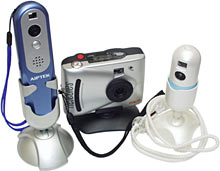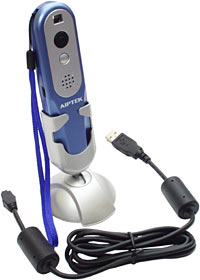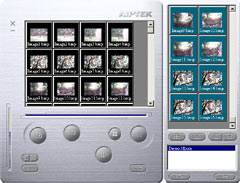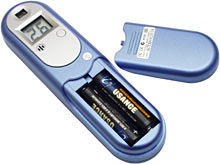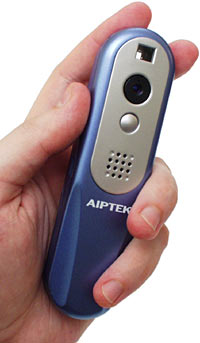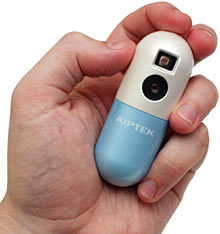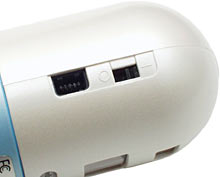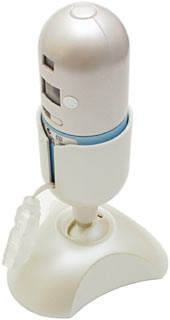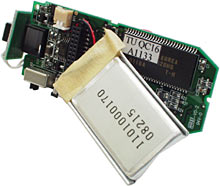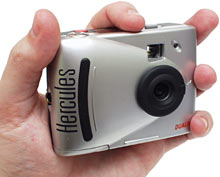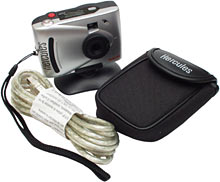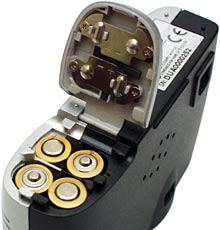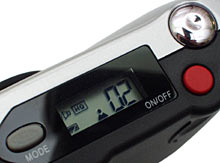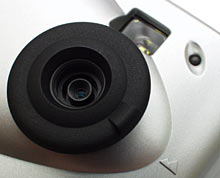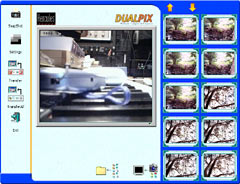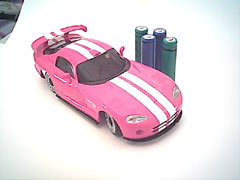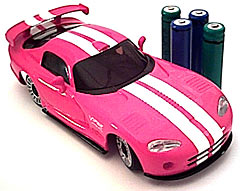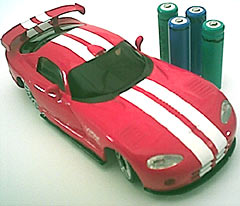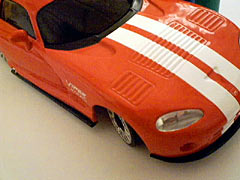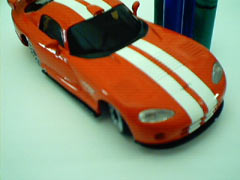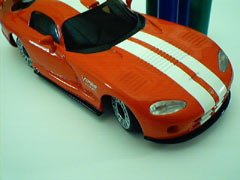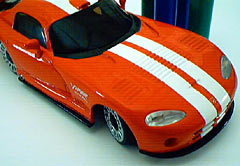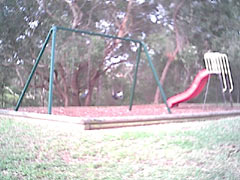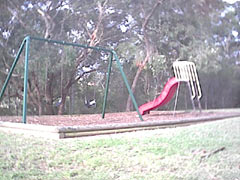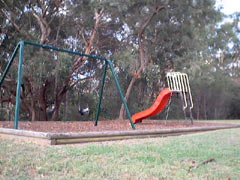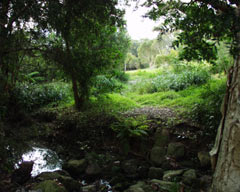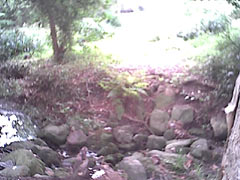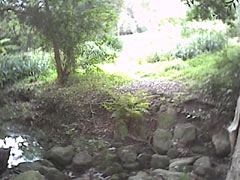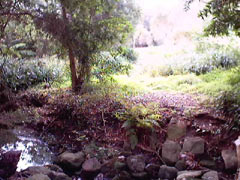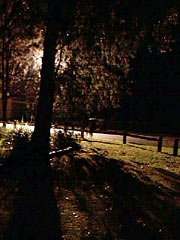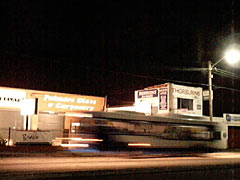
Cheap digital camera comparison - Aiptek PenCam VR 2 and PenCam Ultra versus Hercules DualPix
Review date: 20 December 2001.Last modified 03-Dec-2011.
Digital camera technology may be advancing every day, but if you've only got around $US100 to spend on a digital camera, you're still not going to get anything all that amazing.
The super-cheapie digicam market sector didn't even exist until a few years ago, but it's been around long enough now to have gained a definite character. Super-cheapies give you, basically, a webcam with batteries and a bit of storage. No flash. No expandable memory. Not nearly enough resolution for photo quality, photo sized prints, even if you've got a really funky printer. And a cheap CMOS image sensor that produces pictures that need quite a bit of post-production if you want them to look nice.
Autofocus? Nope. Zoom? Nuh-uh. Little LCD screen for reviewing your images? Oh, wait just a moment, I think I left that feature with my friend Mr Are You Out Of Your Mind. Wait a moment and I'll get it for you.
On the plus side, super-cheap baby-cams are not as lousy as they once were. 640 by 480 models are commonly available now, versus the lousy 352 by 288 (or even worse) sensors in the early models, like, for instance, the original Aiptek cameras I reviewed here.
There's storage for a decent number of pictures in many of the current baby-cams, plus extra features like video clip and/or audio recording. Not to mention some exceedingly funky design.
Behold, therefore, three recent contenders in this market.
On the left, Aiptek's PenCam Voice Recorder 2, whose packaging screams about its "five in one" capabilities. Digital camera! Voice recorder! Voice annotation! Digital camcorder! PC camera! Slices! Dices! While you do dishes!
If you're thinking that a camera that sells for about $US80 - and for that money, you're likely to be able to buy the more swoopily styled PenCam VR 3, not just this version 2 camera - can't be as all-fired fabulous as the marketing people suggest, then you'd be correct. More in a moment.
On the right in the picture, the Aiptek PenCam Ultra. Which is only about 80mm high, but packs full 640 by 480 PenCam features. For around the $US100 mark, it does what the other PenCam does, without the audio record and playback. The Ultra costs more because it's got a rechargeable battery built in, which is a neat feature for more reasons than one.
In the middle, Hercules' DualPix, which doesn't have the unusual styling of Aiptek's products, but claims 1024 by 768 "XGA" resolution and superior image quality.
On with the show. First, the hardware details. Then, the preeety peeectures.
PenCam Voice Recorder 2
The PenCam VR 2 gives you a couple of CDs, the instruction sheet, and what you see here. The camera itself, a couple of AAA batteries, a USB cable, a weighted stand and a wrist strap.
The stand's there because this camera, like the other two in this comparison, can work as a webcam in Windows. Plug the micro-USB connector into the tiny socket in the VR 2's side and you can transfer images and sounds to the PC using the included driver software, or you can switch the camera into webcam mode. Which clears its memory, so you'd better have moved any pictures or audio you want to keep first.
In webcam mode, the microphone doesn't work, and the best frame rate the thing can manage in 320 by 240 mode is an unexciting nine frames per second. It'll do, but there are $AU100 webcams with better performance. You can't unplug those and wander around taking pictures, though.
The VR 2's stand also comes in handy if you use the PenCam's 10 second self-timer mode to get yourself into the picture. Otherwise, you've got to lie it on its side on something (or stand it in a blob of chewing gum...). It doesn't have a tripod thread.
The PenCam software bundle's a bunch of OK, but hardly new, applications from Ulead - Photo Express, Photo Explorer and the not very useful Cool 3D. Plus Microsoft NetMeeting, which is a free download. Ah well. Worth what you pay.
And, of course, there's the basic driver program for the camera. You have to use the "PenCam Manager" software to get images out of the camera memory. While the PenCam's tethered to the PC it's a standard Windows video source that any appropriate software should be able to access, but its digital still camera mode is different.
The Aiptek software works in much the same way for both PenCams; it's quite straightforward, if limited. The PenCam VR, gives you an extra voice note feature, which allows you to tack audio clips onto pictures and save the result as a one-frame AVI file with a soundtrack; that's about the extent of the differences.
PenCam Manager shares one highly irritating feature with the software for a variety of other tiny-cams.
The PenCams, you see, store images in their own memory with some sort of compression - but I don't think it's the JFIF used in JPEG files. PenCams don't have much processing power, and they save images practically instantaneously, so there's not a lot of number-crunching going on there. Whatever the compression scheme used, it's not reducing the weight of the data by much; the Hercules DualPix uses JFIF to fit a lot more pictures into its 8Mb of memory than the PenCams can into theirs.
In any case, the only kind of image data you can get out of the PenCams, and various other tiny-cams, is uncompressed. PenCam Manager, like various other dinky little photo-album driver programs, spits out uncompressed BMPs. These let you store titchy VGA-resolution images as 900 kilobyte files, which look no better than a 50k or smaller JPG.
So if you want your photos in a reasonable format, you've got to recompress them yourself. Which you probably can't afford to do, when you're starting out with the product of a super-cheap image sensor and every little bit of image quality's valuable.
Apart from this limitation, PenCam Manager doesn't stink. It's not one of those awful Happy Momma Bear's Snapshot Bakery sorts of programs ("Would you like to make a greeting card? Would you like to make a calendar? Would you like to make a tract encouraging people to visit your church?" "NO! I WOULD JUST LIKE MY PICTURES, IN A FOLDER, PLEASE!").
PenCam Manager lets you get your hands on the images easily enough - it just dumps them in directories named according to the "gallery" name you've selected. And you can string images together into AVI files, and so on. But PenCam Manager is still no better than the software for lots of other very cheap digicams.
You can get the latest PenCam software from Aiptek Taiwan's download page here; the US Aiptek site here has downloads, too, but insists on asking you impertinent questions first. The Taiwanese site just lets you grab the files.
The back of the PenCam VR 2 has the battery bay, the mode button, and the two-digit LCD display. All PenCams use this sort of display and the same basic two button interface - the mode button and the shutter button are all you get, but they work OK. Two-character mode identifiers on the display and a few different beep tones tell you what you need to know about the operation of the camera. Holding the mode button down for a couple of seconds turns the VR 2 off; if you don't press a button for 30 seconds, the camera automatically turns off.
This PenCam's shutter button is located just below its lens, which isn't the greatest possible place for it to be. The distance from the middle of the shutter button to the middle of the lens is only about 15mm, which means it's easy to put your knuckle in the way of the lens. Well, it was easy for me.
The VR2's simple viewfinder is only about as far above the lens as the shutter button is below it, which ought to help reduce parallax error when you're taking close-up shots. Regrettably, the viewfinder is very basic and doesn't even have a frame-indicating rectangle overlay, so you can't tell how well lined up your eye is with the camera. But it worked OK for me.
Now, a few general PenCam caveats.
First, and most importantly - these things have an Anti-Lousy-Picture feature. It's really simple - if there isn't quite a lot of light, they won't take a picture. Instead of the high-pitched beep that means "photo taken" you get a low-pitched one that means "nope!".
"Quite a lot of light", here, means more light than you're likely to have in most lit rooms in your house at night. A single hundred watt bulb will not light a room well enough for you to consistently be able to take PenCam pictures in it, unless your subject is standing under the light - or is the light. Outdoors during the day you're pretty much OK; at other times, you'll find yourself leaning and twisting and fiddling to try to get enough pale-coloured stuff in the image for the camera to take a shot.
My black cat lying on his brown blanket on an armchair, for instance, is unphotographable with the VR 2, and with the PenCam Ultra too - even when I point two lamps at him.
The PenCams' "digital camcorder" function is just a take-lots-of-pictures-in-quick-succession mode. The included software makes it easy to stitch pictures from the camera together into an AVI file, but you don't get sound, you don't get a high frame rate, you don't by default get the same frame rate as the images were recorded in, and the only way to record more than a few seconds (real time) of action is by using the lower-resolution 320 by 240 mode, so you don't fill the memory too quickly.
The continuous-picture mode does, at least, provide you with a way to take pictures of things that aren't bright enough for the camera to photograph normally. You start your run of continuous shots on something bright, then pan to the dark thing. The resultant pictures will probably be astoundingly awful, but they may also, arguably, be better than nothing.
The VR 2's eight megabytes of on-board memory allow it to store 26 640 by 480 images, or 107 320 by 240 ones. That's good. But that memory is volatile - the contents of the RAM are maintained by power from the batteries. So if you take pictures and then leave them in the camera, it'll flatten its batteries in a couple of weeks just sitting on the shelf. And if you remove the batteries, or they go flat, whatever data was in the camera will be lost.
The PenCam lenses are "focus free", to put it the nice way, or "fixed focus", to put it less nicely. Fixed focus works OK for lower resolution cameras, because a larger amount of fuzziness is tolerable when there are fewer pixels in your image. But if you want a simple webcam-style turn-the-lens focus system that'll let you get really sharp focus for both close-ups and landscape shots, you can't get it from a PenCam; they're set for a compromise focus that ought not to suck too badly for anything. Emphasis on the ought, there - see the image tests below...
The VR 2 and the smaller Ultra both have lenses with two little holes that you ought to be able to stick pointy things in to let you change the focus, but they were both too stiff to move when I tried. I didn't try hooking a set of circlip pliers in 'em and really hauling away, because ripping little CMOS camera modules off circuit boards is not my hobby this week.
Recording audio on the VR 2's easy enough once you figure it out - the multi-language manual sheet tells you that there's an audio record mode, but you have to work out for yourself that you hold the shutter button down in that mode to record. The built-in memory's apparently enough for 13 minutes of record time, which is tons by voice-note standards, though nothing much compared with proper micro-recorders.
The VR 2's interface is unusually flexible, too - it has separate delete-last-audio-clip and delete-last-picture functions, and you can mix audio with images (taking pictures, naturally, reduces the memory available for audio). You can play back all audio clips on the camera by selecting audio-play mode and pressing the shutter button once for the last clip, twice for the second-last one and so on. That's the good news.
The bad news is that the little microphone lurking behind the tiny grille on the back of the PenCam is not very good. It won't hear a person talking in a normal voice unless they're only a few inches away from it, but it seems to be really good at picking up extraneous noise.
So this note-taker has lots of storage, but that just lets you store a lot of hard-to-understand garbled notes. I found it difficult to judge the point where a note would be neither too faint to hear nor too loud and distorted.
If the microphone worked in webcam mode, of course, it'd be pointed in the opposite direction from the lens, allowing it to listen to birds out the window and the power supply fan of the computer it was plugged into. So it's no great loss that it doesn't.
PenCam Ultra
I get the feeling that Aiptek isn't aiming this product at big hairy men who subscribe to Soldier of Fortune and own Rottweilers.
If you happen to be a bouncy 19 year old female style leader, on the other hand, the PenCam Ultra probably looks exactly the way you want a camera to look.
The micro-size casing of the Ultra, though, creates another usability problem. The shutter button's on the top of the casing out of the way of the lens, but the whole thing's so teeny that it's easy to hold it in such a way that one of your fingers partly occludes the image. When I was using the Ultra, I had to keep reminding myself to hold it delicately by the sides.
Generally, the Ultra behaves like the PenCam VR 2; same tiny USB connector, same basic interface. It's missing the VR 2's audio features, of course, and also lacks the delete-last-picture option, which is a bit of a pain. You also can't turn the Ultra off by holding down its mode button (on the back, below the slightly smaller but otherwise standard two digit display), but it's got the same 30 second auto-power-off feature as the VR 2.
You don't have to put batteries in the Ultra, though. It comes with a rechargeable lithium polymer battery already installed, and the battery charges whenever the camera's plugged into a PC. It takes a few hours to charge from its flat out-of-the-box state (during which you can use the camera as a webcam); after that, charging's likely to be considerably faster. There's a bi-colour LED next to the mode button, which glows red when the Ultra's plugged into its USB lead and the battery's charging, and green when it's charged.
On the side of the PenCam Ultra there's another micro USB connector, and a little inset slide switch, which turns the camera completely off. When it's in the on position, the Ultra behaves like any other PenCam, and slowly flattens its battery if there are pictures in the memory. But even if it goes completely flat, at least you don't have to buy more AAA cells.
Put the switch in the off position and it's like removing the AAA cells from one of the other PenCams - you lose the memory contents, but the battery charge is maintained. The camera still works in tethered mode even with the switch off, though.
The Ultra package gives you the camera, another weighted stand, the USB lead and a twinkly neck strap arrangement with a sliding clasp and a nifty pop-loose catch, so you can easily remove the camera from the strap if you need to. There's also a software bundle, exactly the same as the PenCam VR 2's.
The stand has a neat little slot to allow the neck-strap cord to exit.
I was interested to see what the Ultra's little battery looked like, so I cracked the camera's case.
Inside, it's nothing if not tight-packed. That's the little beeper transducer sitting on top of the chip on the lower portion of the board; the CMOS camera module's in the middle, and the viewfinder's on the top. The Ultra is rather thicker than the other PenCams, and so its viewfinder needs another plastic lens element in the middle, which adds some amusing reflection artefacts to your view. The viewfinder oddities don't affect the pictures the camera takes, of course.
The other side of the Ultra's circuit board, with the battery dangling. The battery's only a few millimetres thick, and it's connected to the board with a simple two pin plug, so you could replace it if you use your Ultra enough for the battery to wear out.
Hercules DualPix
The DualPix looks more like a normal camera than the Aiptek offerings, and it works more like one too. It has manual focus adjustment, it has the ability to take pictures no matter how dark it is (they won't necessarily be good pictures, but at least you can try), and the case's layout ought to keep your fat fingers out of the way of the lens when you're taking pictures.
It also has the luxury of a three button user interface - shutter, on/off and mode - and a more helpful LCD display than the PenCams offer.
When I first wrote this review, the DualPix was available here in Australia from Aus PC Market, for $AU214.50 delivered (however, they no longer stock this product). So it cost only a little more than the various PenCam models.
The DualPix hardware kit is a little more luxurious than the PenCam kits. You get the camera, its USB lead, a clip-on weighted stand, a little pouch with a belt loop on it, and a wrist strap. The DualPix has a proper threaded tripod socket on the bottom of it, too.
The DualPix runs from four AAA cells (included), but it shouldn't flatten them as fast as the PenCams do, because it's got flash memory, which needs no power to retain its contents. When the DualPix is turned off, it's really turned off, and doesn't drain its batteries. You can also remove the batteries after taking pictures without losing your data.
The DualPix also offers a 1024 by 768 pixel resolution mode - indeed, it defaults to this "HQ" mode when you turn it on. But its sensor is only 640 by 480, the same as the PenCams; it gets its "XGA" resolution mode by interpolating the image size up inside the camera. That sounds like a complete waste of time, and it is - well, the interpolation is, at least. The XGA mode itself, though, is actually worth using if you need higher image quality, as you'll see in the sample-pictures section below.
The DualPix has a speaker that plays beeps for most functions, plus a typical cheap-digicam cheesy shutter-and-motor-wind sound when you take a picture. The audio feedback's a bit loud for many situations, but better too loud than too quiet - if you want to make it quieter, you can just stick a piece of tape over the speaker grille on the back of the camera.
If you don't want sound at all, hold the mode button down for a few seconds and the DualPix goes into silent mode. It remembers that it's in silent mode when it's turned off, too. When you plug it into its USB lead, though, beep mode turns back on.
Here, the DualPix is saying that it's in XGA mode, its sounds are turned on, it focus is set to infinity, its batteries are in good shape, and two... things... have been stored in its memory.
Those two things may be pictures in either resolution, or they may be video clips. You can mix images and clips as you like, up to the full capacity of the camera.
If you want real video clips, the DualPix can make them. Put it in movie mode and it can shoot silent 320 by 240 AVI clips up to ten seconds in length (well, 9.9 seconds, actually). You just hold the shutter button down while you want the camera to shoot, and it's ready to take another clip right after finishing the last one. Despite the practically nonexistent "cycle time", the clips aren't horrible memory-eating low compression monsters; they're compressed with the Indeo 5.1 codec. So you can just squirt them across to your PC and then e-mail them straight off to someone; anybody with a computer that can play Indeo-compressed AVIs can view them.
The size and frame rate of the clips the DualPix makes depends on the subject matter and lighting. In dim light, moving objects will be blurry, because the camera's using a long shutter speed. On the plus side, blurriness means good compression; an unexciting blurry pan around my computer room gave me a 6.7 frame per second clip that took up 49 kilobytes per second.
When I went outside on a sunny day and panned quickly around various leafy trees instead - creating something of a worst case scenario for compression, with tons of detail in each frame and not much similarity between succeeding frames - the frame rate fell to 3.3 frames per second, but the video still took up a hair more than 100 kilobytes per second.
Static shots with a fair bit of detail in the frame but nothing much moving gave frame rates of about 5.5 to about 6 frames per second and data rates of around 52 kilobytes per second. Then I tried a "lens cap on" clip with the camera pressed against my leg, so every frame was black, and the data rate unsurprisingly plunged to only 11.6k/s. But the frame rate was only 4.4 frames per second, because the camera was using long shutter times, to try to see something.
The DualPix has a burst mode too, that takes five VGA pictures in a bit less than two seconds every time you press the shutter button - and there's only a fraction of a second delay afterwards before you can take another five. This is a rather handy feature for catching quick action.
The DualPix lens assembly looks like a webcam's - you can turn it to focus, and it's got a chunky rubberised surround to make that easy, as well as protect the tiny lens itself from damage.
There's a click-in detent at the most clockwise point in the lens' rotation; that's where you're meant to leave it when you're using the DualPix in carry-around camera mode, and it gives you the usual mid-range-to-infinity fixed-focus sort of setting. But there's nothing stopping you from focussing in closer if you need to. The closest the DualPix can focus is about 30mm from the front of the lens surround, and at that range its whole field of view is only about 20mm across. So it's actually not too bad for basic macrophotography purposes - it manages about 30 pixels per millimetre at its closest setting, or better than 750 dots per inch.
The DualPix viewfinder is just another coaxial plastic-lens job (although it does have a yellow superimposed frame indicator), so you get no feedback on how well focussed the camera is, and it's quite useless for extreme close-ups. If you want to get a sharply focussed close-up picture and you don't have the DualPix tethered to a computer whose monitor you can see, you have to take several shots, tweaking the focus and framing in between.
That's not as hard as you might think, though, since the DualPix has lots of storage. It only has 8Mb of memory - the same amount as the two PenCams - but it stores its images in JPG format, which makes them a lot smaller. Hercules claim the DualPix has room for 27 XGA images or 128 VGA ones, and that seems pretty much right to me.
The DualPix's JPG compression gives it the same cheering feature as more serious digicams that work the same way - the crummier your picture is, the better it's likely to compress. A black frame with one small white dot in it? Small file. A badly blurred mush? Small file. Half picture, half giant fuzzy ghostly thumb? Small file.
Assuming you're not taking super-compressible rubbish pictures, though, Hercules' claim that the camera can store 27 XGA images or 128 VGA ones seems pretty accurate.
The big news in the DualPix software bundle is, unusually, its driver utility. It's a TWAIN driver, which you normally invoke from another program in order to get image data transferred into that other program. But it does more than most TWAIN drivers - it finally solves the horrible-BMP-files problem.
Yes, children - this utility has a simple Save All button that just dumps everything from the camera to a folder. Pictures in JPG format, video clips as AVIs. It puts a dumb little always-on-top box up on the screen while it does it, but you can't have everything. Transferring the full memory contents only took about one minute and 13 seconds when I tried it, so it's not a big pain.
The DualPix utility is still just a TWAIN driver, though, so despite its unusual file-saving abilities, it only does stills, not video. It gives you a live preview of what the camera's seeing, but just so that you can grab frames from it.
To record a video clip you need more capable software, and Hercules oblige with the perfectly all right Video Studio SE, which is yet another Ulead product.
Photos
So what kind of images do these cameras generate?
Glad you asked.
First up, some indoor shots of a random arrangement of colourful objects.
Here's the test scene, as viewed by my Olympus C-2500L (reviewed here). The batteries in the background are AA size, for scale. Click the picture for a 640 by 480 version, scaled down from the 2500L's native 1712 by 1368.
The 2500L's hardly a new camera now, but it still takes better pictures than all but the nicest consumer digicams, and it still sells for a great deal more than all three of the little cameras put together. I provide this picture not for quality comparison purposes, but just to show you what colour the target objects actually are.
I took pictures of this test scene at two light levels - once with the room lit by just the hundred watt bulb in the ceiling fixture, and once with 600 more watts of illumination pointing at the ceiling, and a 40 watt bulb pointed at the test scene from a few feet away. That's an unrealistically high light level for night time indoor shots, but it's low for a sunlit room during the day.
This is the low light output from the PenCam VR 2 (click for the full-resolution version). It's grainy and it's pale, and I had to jockey around a bit to get the camera to take a shot at all, which is why you can see the edge of the paper backdrop. But it doesn't totally stink.
Here's the VR 2's high light output, from the same angle. Much less grain, but it's still washed out.
You can easily do something about that, though. Any vaguely decent image editing program, including the ones that all three of these little-cams give you, lets you play with contrast and brightness and colour saturation and sharpness. And there's often also a general make-this-photo-nicer button, which produces results about as good as anybody could, if they were starting from a tiny-cam picture.
20 seconds of Photoshop tweaking, including cropping out the extra background, turned the VC 2's high light picture into this. The little Dodge Viper still looks a bit as if it belongs to the proprietor of Hair By Nigel, but it's less pink than it was, and the picture's really not too bad.
It's also surprisingly sharp - the focus of the VC 2 I got for review is set rather close. This is good, if you want to take pictures of things within arm's reach of the camera. It's bad, if you don't. More on that in a moment.
Here's the PenCam Ultra's view of the indoor low light test scene. Grainy, once again, but for some reason the little capsule-cam has a much better idea of the actual hue of the little red car.
Turn on the big lights, and the graininess once again goes away...
...which allows one to make a tweaked-up picture that doesn't look too foul at all. The colour balance is good, and the focus isn't too bad - it's fuzzier, yes, but that's because the PenCam Ultra I got for review has a more general-purpose mid-field focus setting than the VC 2 I got.
On to the DualPix. I got in closer this time, so I could play with the DualPix's adjustable focus. This low light picture's taken with the default infinity focus setting, and it's rather fuzzy, but the DualPix's large image capacity means it's very easy to tweak the focus a little, take a picture, tweak it some more, take another, and so on. One of them'll be perfect.
If you've got its sound turned on, the DualPix beeps when you turn the focus from the infinity setting, and it also flashes the little person-icon in its display to indicate to you that if you're about to take a picture of Mount Fuji, it's not going to be any good. It also gives you an extra beep every time you take a picture at other than infinity focus - but it takes the picture just fine.
A little focus-bracketing gave me this quite sharp, though still grainy, low light image...
...which was easy to tweak up into a not-too-awful picture.
Turning on the big lights with the focus at its infinity setting gave more fuzzy images...
...but focus twiddling solved that once again...
...and Photoshop made things quite pretty, once again.
In high illumination, though, the DualPix put some odd alternate-line brightness artifacts into the red portion of the image. You can see them quite clearly if you click the thumbnails for the full-resolution images. I didn't see this effect in any of the other pictures I took with the DualPix, and it's not really obnoxious. But it's peculiar.
And now, some outdoor photography.
Outdoor test scene one, photographed with the C-2500L.
Here's the VC 2's opinion of it. The thumbnail doesn't look completely revolting, but click it for the full image and you'll see that this is quite seriously fuzzy, not to mention rather overexposed. The VC 2's close focus setting lets it down badly when you're out and about.
The PenCam Ultra does a better job of the swing and slide picture. Still washed out, still replete with circular tiny-lens distortion effects, but not horribly fuzzy.
The DualPix beats them both, though. Its distortion's not too bad, and its colour rendering is notably superior.
Another scene - tree branches against the (partially overcast) sky. This sort of picture will show up the limitations of an auto-everything camera that picks its exposure unwisely; if it can't do a half-decent job of this picture, it won't do well on brightly backlit portrait shots, either.
The VR 2, once again, makes a hash of it, thanks to its close focus. The exposure's actually pretty good, though.
The Pen Cam Ultra redeems Aiptek's honour. Only the middle of the image is really in decent focus, with those ugly tiny-lens distortion effects fuzzing out the edges. But the exposure's all right, and the colour isn't too bad either.
Again, though, the DualPix beats them both. Good colour, good exposure, good focus. And no overly disgusting compression artifacts this time, either.
The third and last outdoor scene - an idyllic little creek (a landscaped storm drain on its way to the river, actually, but who's counting) with a brightly lit meadow beyond it. This is another exposure-test scene, and it's also got a ton of detail which can show up overenthusiastic compression algorithms.
For the above shot, I set the C-2500L's exposure so that the meadow in the background is on the edge of being overexposed (and the sky certainly is), but there's good detail in the rocks in the foreground. Intensity curve tweaking would make the picture even nicer, but I didn't do any; this is just the scaled picture straight off the memory card.
And here's the VC 2's typically lousy look at it. Same old story - focus lousy, distortion nasty. And most of the scene is pretty dimly lit, so the VC 2 decided to set its exposure rather high, resulting in quite bright rocks and a nuclear-blast background.
The PenCam Ultra overexposed the background as well, but not as badly, and it did a better job on the rest of the scene as well.
But, once again, the DualPix wins. Its background overexposure is the least awful of the three, and everything else looks better, too. But its compression is clearly struggling - all of the crunchy detail in the scene doesn't squish down well into a JPG file not much bigger than 53 kilobytes.
I used this scene, therefore, to check out the difference between the DualPix's VGA mode and its default XGA one. I shot the same scene in both modes, and then compared it with the VGA version which had just been scaled up by a factor of 1.6. Here are some 340 by 255 excerpts of the results.

First, here's the VGA excerpt, scaled up with dumb nearest-neighbour pixel-doubling interpolation, which is easy for very low powered hardware to do quickly, but which is also ugly.
Mmm... crunchy JFIF squares and uneven-sized pixels...
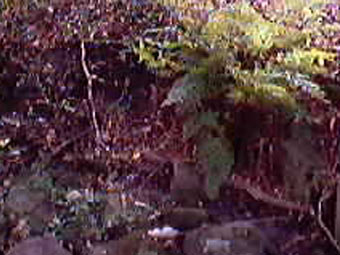
This is the same area, scaled up with more computationally intensive bicubic interpolation. A bit less crunchy, but there's not much difference. If the DualPix's XGA images looked like this, there'd be no point to using that mode.

Fortunately, they look like this. More detail, better colour, less fuzzy. Not an amazing gigantic difference, but a significant one.
Why is this so? Well, the DualPix's JPEG compression, like that of every other baby camera trying to stuff as many pictures as possible into memory, is pretty ferocious. When you use XGA mode, the camera scales the image before it compresses it, and it also uses a noticeably lower level of compression - the 1024 by 768 image has 2.56 times as many pixels as the 640 by 480 one, but the camera saves it as a file about six times as big. VGA images are around 50 kilobytes each, XGA ones are around 300 kilobytes.
If you're doing some maths here and realising that 128 50kb-ish images does not equal eight megabytes, you're right. I didn't manage to fit more than about 6.4Mb into the DualPix's memory. I don't know what the rest of the memory, if it exists, is doing.
I still reckon the actual 1024 by 768 resolution, by itself, is just a marketing tactic - a similarly lower level of compression would make VGA images that looked just as good as the interpolated XGA ones, but had a smaller file size. But it's not a complete waste of time.
Which is good, because the DualPix's default-to-XGA behaviour means you're likely to take a few 1024 by 768 pictures even when you don't mean to, and there's no way to delete just the last picture you took if you use XGA mode by mistake. The VC 2 can do that, but the DualPix can't - it lets you delete everything, or nothing.
Since the DualPix works in any lighting conditions, I felt obliged to do some night shooting with it. If its performance in truly low light turned out to be appalling, after all, then it'd do better to behave like the PenCams and just not let you take pictures.
Fortunately, it actually worked pretty well. I got nothing worthwhile out of really dark scenes, but if a road's got street lights on both sides then you'll be able to get grainy but identifiable pictures of the buildings from the DualPix. Which you can punch up into even grainier, but brighter, versions in an image editor.
The result, replete with vertical-line noise artifacts, has a distinctly lo-fi grungy look about it, but so do quite a lot of the world's best photographs. Reminding you of the subjective nature of perception, and all that.
The following pictures have all been Photoshop-tweaked.
A little Catholic chapel. Note the horizontal lines on the road in front of it; this is a 90 degree rotated image, and they're the vertical-line noise I was talking about.
Road Sign/Street Light Dialectic XVIII. $25,000 or near offer.
Moody night-time tree with a floodlight behind it.
This isn't the world's most appealing vehicle-light-trails-at-night photo, but it demonstrates the principle. You can take such a picture with the DualPix. Photograph a moving vehicle at night and you actually don't have much choice about taking a picture like this, unless you manage to track the vehicle rather well; the exposure's not going to be short. But many tiny-cams won't give you anything worth bothering with in such a situation, if they'll take a picture at all.
According to Hercules' specifications, the longest exposure the DualPix can do is 1/4 second. That's pretty long, for a hand-held camera; you need to be resting the camera on something or standing unusually still to get a sharp photo at one-quarter.
Cheap art!
It's possible to take quite good pictures with a dinky-cam like one of these three. If, of course, you have an interesting subject, and something that could with a following wind qualify as photographic ability, and if you post-process the bejaysus out of the washed-out, grainy output from your cheap little camera.
Evidence for this assertion can be found at Google hit number 1 for "pencam" at the moment, Dave Faris' pencam.org.
If your camera won't take a picture at all, though - and PenCams won't, in anything but quite bright light - then your photographic output is going to be, ah, minimalist. And with no flash, no zoom and a grainy low-res image sensor, there are some hard limits to what can be achieved.
But, as any pinhole photographer will tell you, you do not need fancy gear to take great photos. If your camera doesn't have zoom and doesn't have a flash and doesn't have a lot of resolution then there are obviously some things you just can't do. But then again, the penny whistle is a pretty darn limited instrument, and yet people can play a whole bunch of tunes on them.
Apart from the fact that they're cheap, tiny lightweight cameras make it easy to play with goofy photographic ideas. Press the camera to the trunk of a tree. Stick it up in the marquee lights in front of a shop. Turn it in a circle as you take a shot. Put it on the pavement (turn a PenCam sideways and its lens will be about 15mm above the ground - bug's-eye view!). Use timer mode and spin the camera around on its wrist strap while it takes a shot. Do whatever you want.
Sure, most such pictures will be rubbish, but so what? Every now and then you'll make art by accident.
The secret of great photography is very large amounts of bad photography.
I wandered around the garden with the PenCam Ultra snapping things at random, and five minutes of that, quite a lot of deleting, and then a bit of Photoshop punch-up work resulted in this shot. I don't think it's going to win any awards, and the PVC guttering on the side of the shed in the middle of the frame isn't quite up there with French chateaux and Pictish monoliths in the pantheon of Striking Photographic Subjects, but this is nonetheless quite a pretty picture, I reckon.
And baby-cams are cheap. If your gymnastic photo-taking exercises result in the destruction of your camera, it's not as if you've just dropped a ten thousand dollar object into the ocean.
Overall
The PenCam VR 2, I can take or leave. Even if its focus were more generally useful, its voice recording is dodgy, and there's nothing else in its feature set that distinguishes it from other current PenCams. If you've got no digital camera and someone buys you this one then it's indubitably better than nothing, although it really won't be any use to you for anything but close-ups if the focus of the one I got is representative. But if you're shopping for yourself, you can do better.
The PenCam Ultra is seriously nifty looking; macho it ain't, but if you don't feel that your sexuality is threatened by wearing what appears to be a giant Ecstacy capsule around your neck, this little blighter's not too bad at all. You've got to take a little care using it to make sure you don't stick your finger over the lens, but that's not a big deal once you get used to it. It's not the cheapest baby-cam ever, but you don't have to buy batteries. If only it worked when the light wasn't bright.
If you want to at least have a swing at taking quality photographs, though, the Hercules DualPix is the way to go. It's bigger than the PenCams but still hardly bulky, its user interface beats the Aipteks, it's got a simple image download feature, its 1024 by 768 mode is good for something, and it works at night. Recommended.
Hercules' page for the DualPix
Buy a camera!
Aus PC Market don't sell these products any more (click
here to see their current camera-related products).
